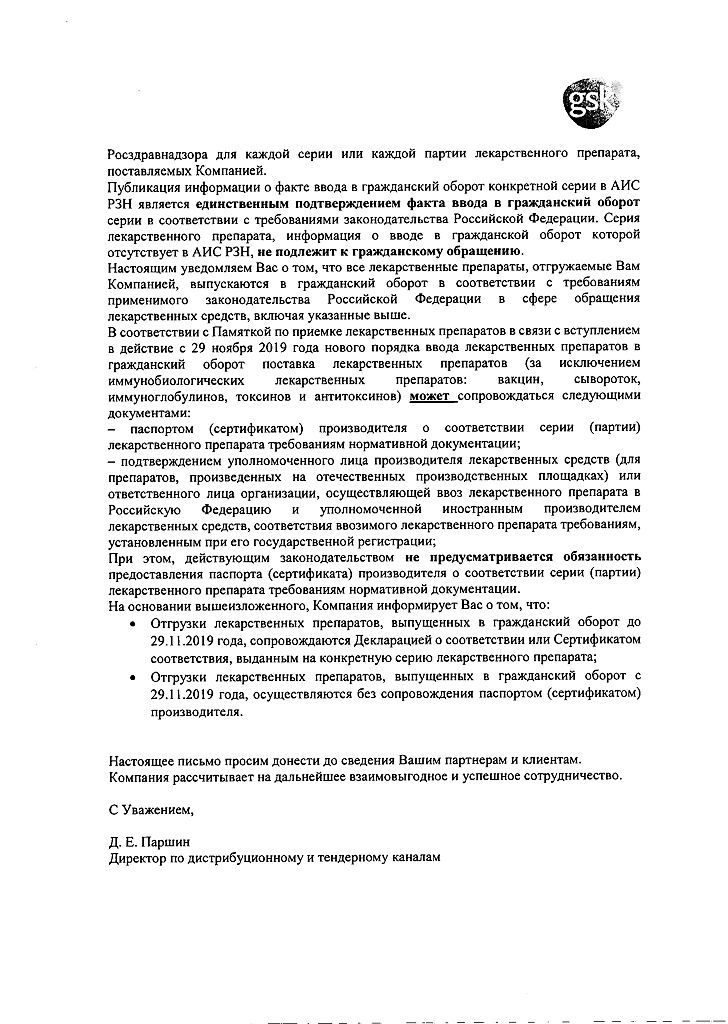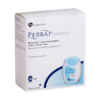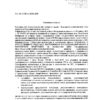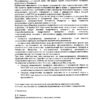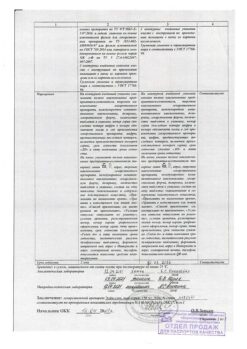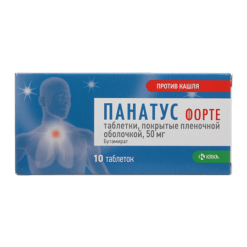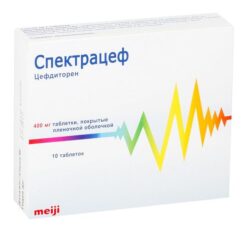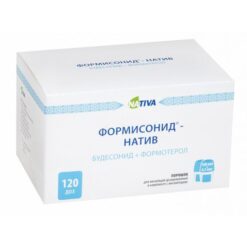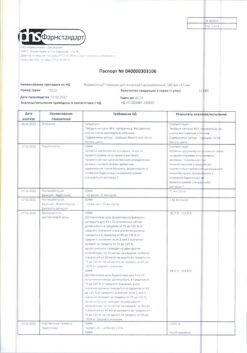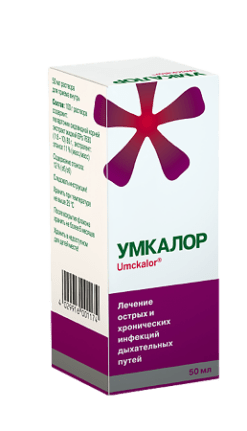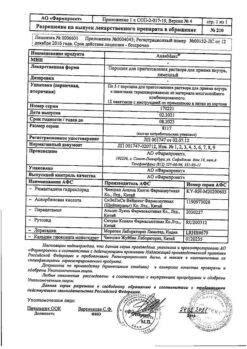No products in the cart.
Relvar Ellipta, 22 mcg+92 mcg/dose 30 doses
€56.50 €47.08
Description
Mechanism of action
Vilanterol and fluticasone furoate belong to two different classes of drugs – a synthetic glucocorticosteroid and a long-acting selective beta2-adrenomimetic.
Pharmacodynamic effects
Vilanterol belongs to the class of long-acting selective beta2-adrenomimetics (DDBA).
Pharmacological effects beta2-adrenoceptor agonists, including vilanterol, are at least in part related to stimulation of intracellular adenylate cyclase, an enzyme that catalyzes the conversion of adenosine triphosphate (ATP) to cyclic 3′,5′-adenosine monophosphate (cyclic AMP). Increase of cyclic AMP level leads to relaxation of bronchial smooth muscle and inhibition of release of mediators of immediate hypersensitivity reactions from cells (primarily from mast cells).
Fluticasone furoate is a synthetic trifluoride glucocorticosteroid with pronounced anti-inflammatory action. The exact mechanism of action to relieve symptoms of bronchial asthma and chronic obstructive pulmonary disease (COPD) is not known.
Glucocorticosteroids have demonstrated a broad spectrum of action on different cell types (e.g., eosinophils, macrophages, lymphocytes) and mediators (e.g., cytokines and chemokines involved in inflammation).
Molecular interactions occur between glucocorticosteroids and DDBAs, whereby the steroid hormones activate the beta2-adrenoreceptor gene, increasing the number of susceptible adrenoreceptors. DDBAs bind to the glucocorticosteroid receptor, ensuring its steroid-dependent activation and stimulating translocation to the cell nucleus.
These synergistic interactions result in enhanced anti-inflammatory activity as revealed in in vitro and in vivo experiments with various inflammatory cells involved in the pathophysiological processes of bronchial asthma and COPD. The results of clinical studies using airway biopsy specimens have also demonstrated the synergy of gducocorticosteroids and DDBA that occurs when these drugs are administered to patients with COPD at therapeutic doses.
Pharmacokinetics
Absorption
. The absolute bioavailability of vilanterol and fluticasone furoate when the combination of vilanterol and fluticasone furoate was inhaled averaged 15.2% and 27.3%. respectively. The oral bioavailability of both substances was low, averaging 1.26% and < 2%. respectively. Given the low oral bioavailability, the systemic effects of vilanterol and fluticasone furoate after inhalation are primarily due to absorption of a portion of the inhaled dose into the lungs.
Distribution
After intravenous administration, vilanterol and fluticasone furoate are actively distributed in the body, with mean equilibrium distributions of 165 L and 661 L, respectively.
The two substances have a low ability to bind to erythrocytes. In in vitro studies, the binding of vilanterol and fluticasone furoag to human plasma proteins was high, reaching an average > 93.9 % and 99.6 %. respectively. The degree of binding to plasma proteins in vitro was not reduced in patients with hepatic and renal dysfunction.
While vilanterol and fluticasone furoate are P-glycoprotein (P-gp) substrates, when combining vilanterol and fluticasone furoate with P-gp inhibitors is administered simultaneously, changes in systemic vilanterol or fluticasone furoate exposure are not considered likely, because both substances have good absorption capacity.
Metabolism
Based on in vitro experiments, it can be concluded that the key metabolic pathways of vilanterol and fluticasone furoate in humans are primarily mediated through the cytochrome CYP3A4 isoenzyme.
Vilanterol is predominantly metabolized by O-dealkylation to form a variety of metabolites with significantly lower beta1- and beta2-adrenomimetic activity.
Fluticasone furoate is predominantly metabolized by hydrolysis of the S-fluoromethylcarbothioate group to form metabolites with significantly lower glucocorticosteroid activity.
The clinical study of drug-drug interactions with cytochrome CYP3A4 isoenzyme was performed using combination of vilanterol and fluticasone furoate (22 mg + 184 mcg/dose) and strong cytochrome CYP3A4 isoenzyme inhibitor – ketoconazole (400 mg) in healthy volunteers. Co-administration of the drugs resulted in a 36% and 33% increase in mean area under the pharmacokinetic curve (AUC(0-24)) and mean Cmax of fluticasone furoate. respectively. Increased exposure to fluticasone furoate was associated with a 27% decrease in mean serum cortisol concentration. measured over a period of 0-24 hours.
The co-administration of a combination of vilanterol and fluticasone furoate and ketoconazole resulted in increases in mean AUC(0-t) and Cmax of vilanterol by 65 and 22 %. respectively. Increased exposure to vilanterol did not increase the systemic effects of beta-agonists, which are characteristic of heart rate, blood potassium, or corrected QT(QTcF) interval.
After oral administration, fluticasone furoate was primarily metabolized in humans to form metabolites that were primarily excreted via the gastrointestinal tract, except for the radioactive dose < 1% excreted in the urine. The estimated plasma elimination half-life of fluticasone furoate after inhalation administration averaged 24 hours.
After oral administration, vilanterol was primarily metabolized in humans to form metabolites that were excreted in the urine and feces at a ratio of approximately 70% and 30% of the radioactive dose, respectively. The plasma elimination half-life of vilanterol after inhalation administration averaged 2.5 hours.
Particular patient groups
A population-based meta-analysis of the pharmacokinetics of vilanterol and fluticasone furoate in patients with bronchial asthma and COPD was conducted in phase III clinical trials. This analysis evaluated the effect of demographic covariates (age, sex, weight, body mass index (BMI), race, and ethnicity) on the pharmacokinetics of vilanterol and fluticasone furoate.
Race
In elderly patients with bronchial asthma or COPD, the AUC(0-24)fluticasone furoate was evaluated. Patients of the East Asian, Japanese, and South Asian races (12-14% of patients) were reported to have, on average, higher AUC(0-24) scores (higher by no more than 53%) compared with patients of the Caucasian race. However, in these populations, there was no evidence of higher systemic exposure, manifested by a more pronounced effect on urinary cortisol excretion over a 24-hour period. No effect of race on the pharmacokinetic parameters of vilanterol was detected in COPD patients.
The average Cmax of vilanterol was 220-287% higher, and the AUC(0-24)was comparable in patients of Asian origin compared with those in other racial groups, as assessed. However, the higher Cmax of vilanterol had no clinically significant effect on heart rate.
Children
There are no recommendations for dosing changes for adolescents (12 years or older). Pharmacoknetics of vilanterol and fluticasone furoate combination in patients younger than 12 years old have not been studied. Safety and efficacy of vilanterol and fluticasone furoate combination in children under 12 years old has not yet been established.
Elderly patients
The effect of age on the pharmacokinetics of vilanterol and fluticasone furoate was studied in a phase III clinical trial including patients with COPD and bronchial asthma.
In patients with bronchial asthma, there was no evidence of an effect of age (12-84 years) on the pharmacokinetic profile of fluticasone furoate and vilanterol.
Despite an increase (37%) in the AUC of vilanterol in patients with COPD throughout the observed age range of 41 to 84 years, there was no evidence of an effect of patient age on the pharmacokinetic profile of fluticasone furoate. In an elderly patient (aged 84 years) with a low body weight (35 kg), the AUC(0-24) of vilanterol would be 35% higher than the result calculated for the population (average COPD patient aged 60 years and 70 kg body weight), while the Cmax of vilanterol would remain unchanged. It is unlikely that these differences are clinically relevant.
Patients with impaired renal function
According to a clinical pharmacological study, severe impaired renal function (creatinine clearance < 30 ml min) does not significantly increase systemic exposure to vilanterol or fluticasone furoate or develop more pronounced systemic effects of glucocorticosteroids or beta2-agonists compared to healthy volunteers. Individual selection of the dose for patients with impaired renal function is not required.
The effect of hemodialysis is not studied.
Patients with impaired liver function
After continuous administration of the combination of vilanterol and fluticasone furoate for 7 days, increased systemic exposure to fluticasone furoate (as measured by AUC”>-24> DO three-fold) compared with healthy volunteers (according to the Child-Pugh classification of cirrhosis: A. cirrhosis stages. B or C). Increased systemic exposure to fluticasone furoate (when administered as a combination of vilanterol and fluticasone furoate at a dose of 22 mcg + 184 mcg/dose) in patients with moderate liver function impairment (Child-Pugh stage B) was associated with an average 34% reduction in serum cortisol concentration compared with healthy volunteers. The dose-normalized systemic exposure to fluticasone furoate in patients with moderate to severe hepatic impairment (Child-Puo stages B and C) was similar. Consequently, although patients with hepatic impairment do not require individualized dose selection, caution should be exercised when prescribing this medication to them.
After continuous administration of a combination of vilanterol and fluticasone furoag for 7 days, no significant increase in systemic vilanterol exposure (Cmax and AUC(0-24)) was observed in patients with mild, moderate, or severe hepatic impairment (Child-Pugh stages A B and C).
In comparison with healthy volunteer patients with mild to moderate hepatic dysfunction (who took vilanterol at a dose of 22 mcg) or severe (who took vilanterol at a dose of 11 mcg), no clinically significant beta-adrenergic systemic effects (changes in heart rate or serum potassium concentration) caused by vilanterol and fluticasone furoate combination were observed.
Gender, body weight, and body mass index (BMI)
. No evidence of an effect of sex, body weight, or BMI on the pharmacokinetic profile of fluticasone furoate was found in a phase III population-based pharmacokinetic analysis that included 1213 patients with bronchial asthma (712 women) and 1225 patients with COPD (392 women).
In a population-based pharmacokinetic analysis involving 856 patients with bronchial asthma (500 women) and 1091 patients with COPD (340 women), no evidence of an effect of sex, body weight, or BMI on the pharmacokinetic profile of vilanterol was found.
No individual dose adjustment based on sex, body weight, or BMI was required.
Indications
Indications
– bronchial asthma;
— COPD (chronic obstructive pulmonary disease).
The use of Relvar Ellipta can reduce the number of exacerbations of COPD in patients with a history of repeated exacerbations.
Pharmacological effect
Pharmacological effect
Mechanism of action
Vilanterol and fluticasone furoate belong to two different classes of drugs – a synthetic glucocorticosteroid and a selective long-acting beta-adrenergic agonist.
Pharmacodynamic effects
Vilanterol belongs to the class of selective long-acting beta2-adrenergic agonists (LABAs).
The pharmacological effects of beta2-adrenergic agonists, including vilanterol, are at least in part due to stimulation of intracellular adenylate cyclase, an enzyme that catalyzes the conversion of adenosine triphosphate (ATP) to cyclic 3′,5′-adenosine monophosphate (cyclic AMP). An increase in the level of cyclic AMP leads to relaxation of bronchial smooth muscles and inhibition of the release of mediators of immediate hypersensitivity reactions from cells (primarily from mast cells).
Fluticasone furoate is a synthetic trifluoride glucocorticosteroid with a pronounced anti-inflammatory effect. The exact mechanism of action to relieve the symptoms of bronchial asthma and chronic obstructive pulmonary disease (COPD) is not known.
Glucocorticosteroids have demonstrated a broad spectrum of action on various cell types (eg, eosinophils, macrophages, lymphocytes) and mediators (eg, cytokines and chemokines involved in inflammation).
Molecular interactions occur between glucocorticosteroids and DDBL, as a result of which steroid hormones activate the beta2-adrenergic receptor gene, increasing the number of receptive adrenergic receptors. LABAs bind to the glucocorticosteroid receptor, providing its steroid-dependent activation and stimulating translocation into the cell nucleus.
These synergistic interactions lead to increased anti-inflammatory activity, which is revealed in in vitro and in vivo experiments with various inflammatory cells involved in the pathophysiological processes of the development of bronchial asthma and COPD. The results of clinical studies using respiratory tract biopsies also demonstrated the synergy between glucocorticosteroids and LABAs that occurs when these drugs are prescribed to patients with COPD at therapeutic doses.
Pharmacokinetics
Suction
The absolute bioavailability of vilanterol and fluticasone furoate during inhalation administration of the combination of vilanterol and fluticasone furoate averaged 15.2% and 27.3%. respectively. Oral bioavailability of both substances was low, averaging 1.26% and <2%. respectively. Taking into account the low oral bioavailability, the systemic effect of vilanterol and fluticasone furoate after inhalation is primarily due to the absorption of the portion of the inhalation dose that reaches the lungs.
Distribution
After intravenous administration, vilanterol and fluticasone furoate are actively distributed in the body, with average volumes of distribution at steady state being 165 L and 661 L, respectively.
Both substances have a low ability to bind to red blood cells. In in vitro studies, the binding of vilanterol and fluticasone furoag to human plasma proteins was high and reached an average of > 93.9% and 99.6%. respectively. The degree of binding to plasma proteins in vitro was not reduced in patients with impaired liver or kidney function.
Although vilanterol and fluticasone furoate are P-glycoprotein (P-gp) substrates, when co-administering a combination of vilanterol and fluticasone furoate with P-gp inhibitors, changes in the systemic exposure of vilanterol or fluticasone furoate are considered unlikely, since both substances are well absorbed.
Metabolism
Based on in vitro experiments, it can be concluded that the key metabolic pathways of vilanterol and fluticasone furoate in the human body are primarily mediated through the cytochrome CYP3A4 isoenzyme.
Vilanterol is predominantly metabolized by O-dealkylation with the formation of a number of metabolites with significantly lower beta1- and beta2-adrenomimetic activity.
Fluticasone furoate is predominantly metabolized by hydrolysis of the S-fluoromethylcarbothioate group to form metabolites with significantly lower glucocorticosteroid activity.
A clinical study of drug interactions with the cytochrome CYP3A4 isoenzyme was conducted with long-term administration of a combination of vilanterol and fluticasone furoate (22 mcg + 184 mcg/dose) and a strong inhibitor of the cytochrome CYP3A4 isoenzyme – ketoconazole (400 mg) using healthy volunteers as an example. Co-administration of the drugs resulted in an increase in the mean area under the pharmacokinetic curve (AUC(0-24)) and mean Cmax of fluticasone furoate by 36% and 33%. respectively. Increased exposure to fluticasone furoate was associated with a 27% decrease in mean serum cortisol concentrations. measured over a period of 0-24 hours.
Co-administration of a combination of vilanterol and fluticasone furoate and ketoconazole resulted in an increase in the mean AUC(0-t) and Cmax of vilanterol by 65 and 22%. respectively. Increasing exposure to vilanterol did not lead to an increase in systemic effects characteristic of beta-agonists – effects on heart rate, potassium levels in the blood, or corrected QT(QTcF) interval.
Removal
Following oral administration of fluticasone furoate in humans, it was primarily metabolized to form metabolites that were predominantly excreted through the gastrointestinal tract, with the exception of <1% radioactive dose excreted in the urine. The estimated plasma half-life of fluticasone furoate after inhalation administration of the drug averaged 24 hours.
Following oral administration, vilanterol in humans was primarily metabolized to form metabolites that were excreted in urine and feces at approximately 70% and 30% of the radioactive dose, respectively. The plasma half-life of vilanterol after inhalation administration of the drug averaged 2.5 hours.
Special patient groups
During the third phase of clinical trials, a population-based meta-analysis of the pharmacokinetics of vilanterol and fluticasone furoate in patients with bronchial asthma and COPD was conducted. This analysis assessed the effect of demographic covariates (age, sex, weight, body mass index (BMI), race and ethnicity) on the pharmacokinetics of vilanterol and fluticasone furoate.
Race
In elderly patients with bronchial asthma or COPD, the AUC (0-24) of fluticasone furoate was assessed. According to the data obtained, patients of East Asian, Japanese and South Asian race (12-14% of patients) had on average higher AUC (0-24) scores (no more than 53% higher) compared to Caucasian patients. However, in these populations there was no evidence of higher systemic exposure manifested by a greater effect on urinary cortisol excretion over a 24-hour period. In patients suffering from COPD, the influence of race on the pharmacokinetic parameters of vilanterol was not detected.
On average, vilanterol Cmax was 220-287% higher and AUC(0-24) was comparable in Asian patients compared to other racial groups. However, the higher Cmax of vilanterol did not have a clinically significant effect on heart rate.
Children
For adolescents (12 years of age or older), there are no recommendations for changing the dosage regimen. The pharmacokinetics of the combination of vilanterol and fluticasone furoate in patients under 12 years of age have not been studied. The safety and effectiveness of the combination of vilanterol and fluticasone furoate in children under 12 years of age have not yet been established.
Elderly patients
The effect of age on the pharmacokinetics of vilanterol and fluticasone furoate was studied in phase 3 clinical studies that included patients with COPD and bronchial asthma.
In patients with bronchial asthma, there was no evidence of an effect of age (12-84 years) on the pharmacokinetic profile of fluticasone furoate and vilanterol.
Despite an increase (37%) in the AUC of vilanterol in patients with COPD throughout the observed age range from 41 to 84 years, there was no evidence of an influence of patient age on the pharmacokinetic profile of fluticasone furoate. In an elderly patient (aged 84 years) with a low body weight (35 kg), the AUC(0-24) of vilanterol would be 35% higher than that calculated for the population (average COPD patient aged 60 years and weighing 70 kg), while the Cmax of vilanterol would remain unchanged. It is unlikely that these differences are clinically relevant.
Patients with impaired renal function
According to a clinical co-pharmacological study, severe renal impairment (creatinine clearance <30 ml min) does not lead to a significant increase in the systemic exposure of vilanterol or fluticasone furoate or to the development of more pronounced systemic effects of glucocorticosteroids or beta2-agonists in comparison with healthy volunteers. Individual dose selection for patients with impaired renal function is not required.
The effect of hemodialysis has not been studied.
Patients with liver dysfunction
After continuous administration of a combination of vilanterol and fluticasone furoate for 7 days, patients with impaired liver function experienced an increase in systemic exposure to fluticasone furoate (as measured by AUC “> -24> up to three times) compared with healthy volunteers (according to the Chill-Pugh classification of liver cirrhosis: stage A. B or C of cirrhosis). An increase in systemic exposure to fluticasone furoate (when prescribing a combination of vilanterol and fluticasone furoate at a dosage of 22 mcg + 184 mcg/dose) in patients with moderate hepatic impairment (Child-Pyot stage B) was associated with a decrease in serum cortisol concentrations by an average of 34% compared with healthy volunteers. Dose-normalized systemic exposure to fluticasone furoate was similar in patients with moderate to severe hepatic impairment (Child-Pyotr stages B and C). Therefore, although patients with impaired liver function do not require individual dosing, caution should be exercised when prescribing this drug to them.
After continuous administration of the combination of vilanterol and fluticasone furoag for 7 days in patients with mild, moderate or severe liver dysfunction (Child-Pugh stages A B and C), there was no significant increase in the systemic exposure of vilanterol (based on Cmax and AUC (0-24)).
Compared with healthy volunteers, in patients with mild to moderate hepatic impairment (treated with vilanterol 22 mcg) or severe (treated with vilanterol 11 mcg), no clinically significant beta-adrenergic systemic effects (changes in heart rate or serum potassium concentration) were observed with the combination of vilanterol and fluticasone furoate.
Gender, body weight, body mass index (BMI)
According to the third phase of population pharmacokinetics analysis, which included 1213 patients with bronchial asthma (712 women) and 1225 patients with COPD (392 women), there was no evidence of the influence of gender, body weight or BMI on the pharmacokinetic profile of fluticasone furoate.
According to a population pharmacokinetic analysis involving 856 patients with bronchial asthma (500 women) and 1091 patients with COPD (340 women), there was no evidence of an effect of gender, body weight or BMI on the pharmacokinetic profile of vilanterol.
Individual dose selection is not required based on gender, body weight or BMI.
Special instructions
Special instructions
Relvar Ellipta® is not intended for the relief of acute symptoms of bronchial asthma or exacerbation of COPD; in such cases, the prescription of short-acting bronchodilators is required. An increase in the frequency of taking short-acting bronchodilators to relieve symptoms indicates a deterioration in disease control and the need to consult a doctor. Patients with bronchial asthma or COPD should not stop treatment with Relvar Ellipta® without medical supervision, because discontinuation of therapy may lead to exacerbation of the disease.
As with other types of inhalation therapy, paradoxical bronchospasm may develop after taking the drug, accompanied by a rapid increase in wheezing. In this case, emergency prescription of a short-acting inhaled bronchodilator and immediate discontinuation of the drug Relvar Ellipta® are indicated. The patient should be examined by a physician and alternative therapy may be prescribed if necessary.
During treatment with Relvar Ellipta®, adverse events associated with the course of bronchial asthma or exacerbation of the disease may develop. Patients should be advised to continue treatment. If the disease is not controlled or the condition worsens after starting therapy with Relvar Ellipta®, consultation with a doctor is necessary.
When using inhaled corticosteroids (especially with long-term use in high doses), systemic side effects may develop. Such side effects develop much less frequently than with oral administration of GCS. Manifestations of possible adverse systemic effects include: suppression of the function of the hypothalamic-pituitary-adrenal axis, decreased bone mineral density, slowed growth rate in children and adolescents, cataracts and glaucoma.
In patients with COPD receiving Relvar Ellipta®, there was an increase in the incidence of pneumonia, as well as the incidence of severe forms of pneumonia requiring patient hospitalization. In some cases, clinical episodes of pneumonia were fatal. Physicians should be aware of the possibility of pneumonia in patients with COPD, not forgetting that the clinical signs of such an infectious disease are masked by symptoms of exacerbation of COPD. The following groups of patients with COPD have the highest risk of developing pneumonia while taking Relvar Ellipta®: smoking patients, patients who have previously had pneumonia, patients with a BMI <25 kg/m2 and patients with a forced expiratory volume in the first second (FEV1) <50% of normal values. When prescribing therapy with Relvar Ellipta®, the above factors should be taken into account; if pneumonia occurs, treatment should be reconsidered.
In patients with bronchial asthma, cases of pneumonia were observed infrequently. Patients with bronchial asthma receiving Relvar Ellipta 22 + 184 mcg/dose may have had a higher risk of developing pneumonia compared to patients receiving a lower dose of Relvar Ellipta 22 + 92 mcg/dose or placebo. Risk factors have not been established.
In clinical trials in patients with COPD, a low incidence of bone fractures was found in all treatment groups, but in all groups receiving the combination of vilanterol and fluticasone furoate, it was slightly higher (2%) than in the group receiving vilanterol 22 mcg monotherapy (<1%).
Impact on the ability to drive vehicles and operate machinery. Studies have not been conducted to study the effect of Relvar Ellipta® on the ability to drive vehicles and operate machinery. Based on the pharmacology of vilanterol or fluticasone furoate, an adverse effect of the drug on these activities is not expected.
Active ingredient
Active ingredient
Vilanterol, Fluticasone furoate
Composition
Composition
Powder for inhalation
Active ingredient:
vilanterol triphenatate micronized 40 mcg (equivalent to 25 mcg vilanterol);
Excipients:
magnesium stearate – 125 mcg;
lactose monohydrate – up to 12.5 mg.
Contraindications
Contraindications
– severe allergic reactions to milk protein or hypersensitivity to the active substances or any other component) included in the drug in the anamnesis;
– children under 12 years of age for the treatment of bronchial asthma;
– treatment of COPD at a dose of 22 mcg + 184 mcg/dose.
With caution: when taking sympathomimetics, including the drug Relvar Ellipta, adverse events such as arrhythmia (for example, supraventricular tachycardia and extrasystole) may be observed in the cardiovascular system. In this regard, patients suffering from severe forms of cardiovascular disease should be prescribed Relvar Ellipta with caution.
Side Effects
Side Effects
Infectious and parasitic diseases: often – pneumonia, upper respiratory tract infections, bronchitis, influenza, candidiasis of the oral cavity and pharynx.
From the nervous system: very often – headache.
From the side of the heart: infrequently – extrasystole.
From the respiratory system, chest and mediastinal organs: very often – nasopharyngitis; often – oropharyngeal pain, sinusitis, pharyngitis, rhinitis, cough, dysphonia.
From the gastrointestinal tract: often – abdominal pain.
From the musculoskeletal and connective tissue side: often – arthralgia, back pain, fractures.
General disorders and disorders at the injection site: often – fever.
Interaction
Interaction
When the drug is prescribed in therapeutic doses, clinically significant drug interactions with vilanterol or fluticasone furoate are considered unlikely due to the low plasma concentrations of the latter when administered by inhalation.
Beta-blockers may weaken or antagonize the effect of beta2-agonists. The simultaneous use of non-selective and selective beta-blockers should be avoided unless their use is strictly necessary.
Vilanterol and fluticasone furoate undergo rapid primary metabolism in the liver via the cytochrome CYP3A4 isoenzyme.
When prescribing the drug simultaneously with strong inhibitors of the cytochrome CYP3A4 isoenzyme (for example, ketoconazole, ritonavir), caution should be exercised, since it is possible to increase the systemic exposure of vilanterol and fluticasone furoate, which in turn can lead to an increased risk of adverse reactions (see “Pharmacokinetics”).
Vilanterol and fluticasone furoate are P-gp substrates. According to the results of a clinical and pharmacological study involving healthy volunteers who were simultaneously prescribed vilanterol and a strong inhibitor of P-gp and a moderate inhibitor of the cytochrome CYP3A4 isoenzyme verapamil, no significant effect on the pharmacokinetics of vilanterol was detected. Clinical and pharmacological studies of the co-administration of a specific P-gp inhibitor and fluticasone furoate have not been conducted.
Overdose
Overdose
Symptoms: during clinical studies, there was no evidence of an overdose of the combination of vilanterol and fluticasone furoate. It is possible to develop symptoms and signs caused by the action of individual components of the drug and characteristic of an overdose of beta2-agonists and inhaled corticosteroids.
Treatment: There is no specific treatment. Symptomatic therapy is prescribed and, if necessary, appropriate monitoring of the patient is provided. The use of cardioselective beta-blockers should be considered only in cases of severe effects of vilanterol overdose, which are clinically manifested by refractoriness to supportive therapy. Cardioselective beta-blockers should be prescribed with caution to patients who have had a history of episodes of bronchospasm.
Storage conditions
Storage conditions
In a place protected from light, at a temperature not exceeding 25 °C.
Shelf life
Shelf life
2 years
Manufacturer
Manufacturer
Glaxo Operations UK Ltd, UK
Additional information
| Shelf life | 2 years |
|---|---|
| Conditions of storage | In a light-protected place at a temperature not exceeding 25 °C. |
| Manufacturer | Glaxo Operations UK Ltd, United Kingdom |
| Medication form | metered inhalation powder |
| Brand | Glaxo Operations UK Ltd |
Related products
Buy Relvar Ellipta, 22 mcg+92 mcg/dose 30 doses with delivery to USA, UK, Europe and over 120 other countries.



